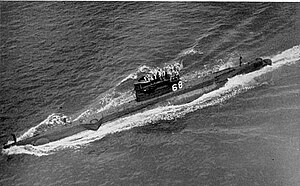USS O-7

| |
| History | |
|---|---|
| Name | O-7 |
| Ordered | 3 March 1916 |
| Builder | Fore River Shipbuilding Company, Quincy, Massachusetts |
| Laid down | 14 February 1917 |
| Launched | 16 December 1917 |
| Commissioned | 4 July 1918 |
| Decommissioned | 1 July 1931 |
| Recommissioned | 12 February 1941 |
| Decommissioned | 2 July 1945 |
| Stricken | 11 July 1945 |
| Fate | Sold for scrap, 22 January 1946 |
| General characteristics | |
| Type | O-class submarine |
| Displacement |
|
| Length | 172 ft 3 in (52.5 m) |
| Beam | 18 ft 1 in (5.5 m) |
| Draft | 14 ft 5 in (4.4 m) |
| Installed power |
|
| Propulsion |
|
| Speed |
|
| Range | 5,500 nmi (10,200 km; 6,300 mi) at 11.5 knots (21.3 km/h; 13.2 mph) on the surface |
| Test depth | 200 feet (61.0 m) |
| Complement | 2 officers, 27 enlisted |
| Armament | |
USS O-7 (SS-68) was one of 16 O-class submarines built for the United States Navy during World War I.
Description[edit]
The O-class submarines were designed to meet a Navy requirement for coastal defense boats.[1] The submarines had a length of 172 feet 3 inches (52.5 m) overall, a beam of 18 feet 1 inch (5.5 m) and a mean draft of 14 feet 5 inches (4.4 m). They displaced 521 long tons (529 t) on the surface and 629 long tons (639 t) submerged. The O-class submarines had a crew of 29 officers and enlisted men. They had a diving depth of 200 feet (61.0 m).[2]
For surface running, the boats were powered by two 440-brake-horsepower (328 kW) diesel engines, each driving one propeller shaft. When submerged each propeller was driven by a 370-horsepower (276 kW) electric motor. They could reach 14 knots (26 km/h; 16 mph) on the surface and 10.5 knots (19.4 km/h; 12.1 mph) underwater. On the surface, the O class had a range of 5,500 nautical miles (10,200 km; 6,300 mi) at 11.5 knots (21.3 km/h; 13.2 mph).[2]
The boats were armed with four 18-inch (450 mm) torpedo tubes in the bow. They carried four reloads, for a total of eight torpedoes. The O-class submarines were also armed with a single 3"/50 caliber deck gun.[2]
Construction and career[edit]
O-7 was laid down on 14 February 1917 by the Fore River Shipbuilding Company in Quincy, Massachusetts. She was launched on 16 December 1917 sponsored by Mrs. Constance Sears, and commissioned on 4 July 1918 with Lieutenant Commander Frederick C. Sherman, in command. During the final stages of World War I, O-7 operated out of Philadelphia, Pennsylvania, on coastal patrol from Cape Cod to Key West, Florida. On 2 November she departed Newport, Rhode Island, with a 20-sub contingent bound for European waters, however, the Armistice with Germany was signed before the ships reached the Azores, and they returned to the United States.
In 1919, O-7 reported to the newly established Submarine School at New London, Connecticut, to train there for the next decade. In 1924, she went to Coco Solo for maneuvers and was reclassified a second line submarine on 25 July 1924. Returning to New London, she reverted to first line on 6 June 1928. In January 1930, she joined her sister ships in a run to Portsmouth, New Hampshire, thence back to New London in February. After returning from Washington, DC. in July, she continued operations at New London. She sailed to Philadelphia, Pennsylvania, on 23 February 1931 and decommissioned there on 1 July 1931.
After a decade in mothballs, O-7 was recalled to active duty and recommissioned at Philadelphia 12 February 1941. She reported to New London in May and trained sub crews there until the end of World War II. O-7 was decommissioned on 2 July 1945; was struck from the Naval Vessel Register on 11 July 1945; and sold to North American Smelting Company of Philadelphia on 22 January 1946.
Notes[edit]
References[edit]
- Friedman, Norman (1995). U.S. Submarines Through 1945: An Illustrated Design History. Annapolis, Maryland: Naval Institute Press. ISBN 1-55750-263-3.
- Gardiner, Robert & Gray, Randal, eds. (1985). Conway's All the World's Fighting Ships 1906–1921. Annapolis, Maryland: Naval Institute Press. ISBN 0-85177-245-5.
- This article incorporates text from the public domain Dictionary of American Naval Fighting Ships. The entry can be found here.
External links[edit]
- Photo gallery of USS O-7 at NavSource Naval History
